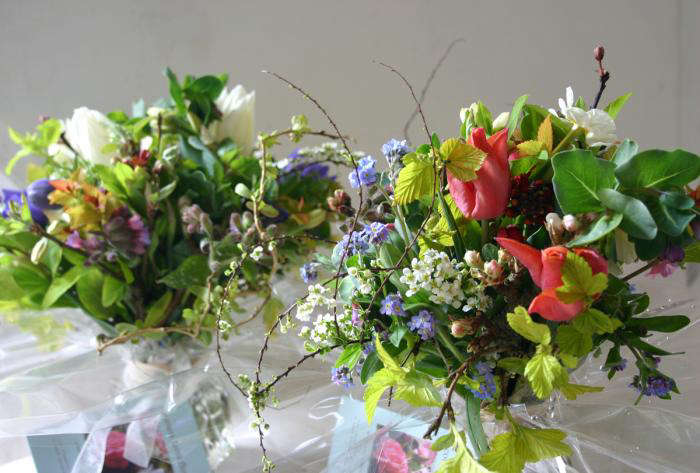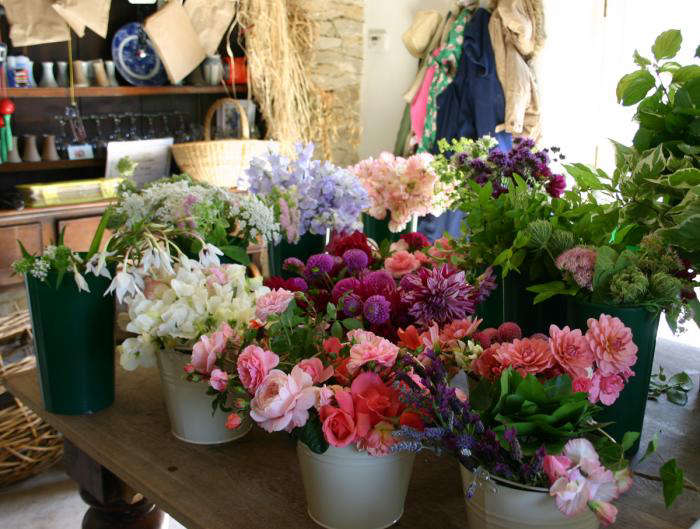If you are planning a spring or summer wedding, you can grow your own artfully unstudied bouquets–if you start planning now with military precision. “If you’re doing the home-grown look, there is a fine line between messy and stunning,” warns Georgie Newbery, who grows English flowers at Common Farm, in Somerset. “You want people to think: how clever, how imaginative… Not: how home-made.” Here are her secrets:
Photographs by Georgie Newbery, except where noted.

Above: Start small. Why not sow some sweet peas right now? If you think about annuals that you like and keep sowing, little and often, you’ll have plenty. They’ll be seasonal, local, and unique. Sow some seeds and make some lists: you are on your way to grow your own wedding flowers. List-making and good presentation are qualities which Georgie picked up during her years in Paris assisting the bureau chief of American Vogue.

Above: Flowers to sow now which will give generously on the day: ammi majus, cornflowers, snadragons, cerinthe Major Purpurescans, Clary sage, and of course sweet peas. They are all suprisingly bountiful. This is the key if you want to grow your own wedding flowers. One cornflower will provide for three weddings: just keep cutting and feeding it. Three rows of sweet peas, grown like runner beans–not entwined around something pretty–will give you 700 stems at exactly the right moment. Just make sure you pick everything flowering on Monday to get flower production up for a Thursday night plundering. Georgie gets her seeds from Moles.

Above: Flowers need feeding and so does the soil. “Feed your garden every two weeks,” advises Georgie. “I grow a quarter of an acre of comfrey for this purpose.” Comfrey “tea” is applied in summer, flollowing lashings of nettle tea in spring. Tender annuals to sow in spring might include cosmos, sunfowers, zinnias (“they don’t wilt”) and dahlias, which are treated as annuals since they are lifted every year.

Above: For a spring wedding, bulbs to plant now would be tulips, scented narcissi and alliums. Pots planted with bulbs can be brought indoors earlier for forcing or if they are taking too long to do do their stuff. Large pots also look wonderful framing an entrance, filled with bulbs or trees and shrubs. Think about using plants which could be planted in the garden afterwards, like hydrangea, roses, apple trees. Just keep feeding them before the wedding.

Above: Good “investment” plants for cut wedding flowers are roses and hydrangeas as mentioned, as well as cotinus and viburnum for foliage. The advantage of home-grown flowers is that they can be cut a day or two before. Florists tend to cut them a week before and “stop” them in silver nitrate.

Above: Three weeks before the big day, sit down and make a posy. The amount of flowers involved and the time it takes is key in your planning. Make a list, even a spread sheet, of what you need to cut. Find helpers for the day before, each with their own list. “It will be stressful and tiring if you’re not prepared,” warns Georgie. But with 10 people making four posies each, it could be… fun. Start cutting your wedding on Wednesday night, and do most of it on Thursday, with a list and a clean bucket of water, “You can cut a whole wedding in an evening,” says Georgie calmly. It should be after 6pm and everything needs to be kept cool from then on.

Above: “I expect flowers to work like supermodels,” says Georgie, “and make nice shapes.” She administers tough love. “For a heavy-headed flower, stab it through the neck with wire before twisting it round the stalk,” she says. “It won’t mind.” Photograph by Kendra Wilson.

Above: You cannot have too much fine wire and stemtex (the green ribbon which is slightly sticky on one side). On the Friday before a Saturday wedding, 90 per cent of the flowers should be arranged. The flowers for the bride’s bouquet should be chosen first and kept in a separate bucket, followed by flowers for the bridesmaids and the buttonholes for men. They should be made up on the morning. Remember to squeeze the bridal bouquet with a towel.

Above: Buttonholes for the gents and not a carnation in sight. “Men don’t complain about flouncy flowers,” says Georgie of her experiences. “They like having a posy instead of just one flower.”

Above: Sometimes, it’s a good idea to call in a florist to carry out the complicated techniques. You can still provide the essential ingredients: home-grown flowers.

Above: Instead of spending a small fortune on wedding favors, why not make posies for the tables which can be taken home? Keep industrial quantities of raffia to hand. Posies tied with raffia will transport better and can make all the difference between a rustic mob and an elegant arrangement.

Above: Jam jars, pitchers, wine glasses or your granny’s antique jug. Whatever you choose for containers (and you can choose anything if you use floral foam and wire) everything must be cleaned months before and stored upside down. Allow your flowers to have a bit of life to them and try not to get too carried away with the foam and wire. Georgie Newbery likes to draw on the wisdom of her mother, who was a florist at the Dorchester Hotel in London in the 1960s: “If a flower won’t do what you want it to do, let it do what it wants to do.”
For more grow your own wedding flowers inspiration and ideas, see “Design Sleuth: Dried Bouquets for the Winter Months.“








Have a Question or Comment About This Post?
Join the conversation